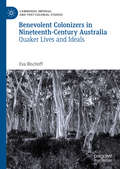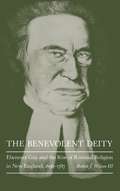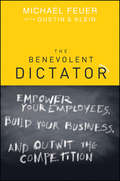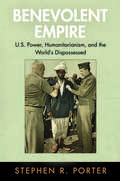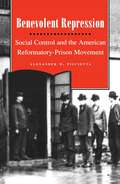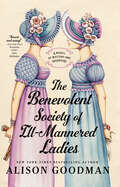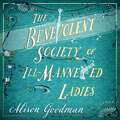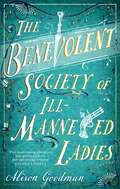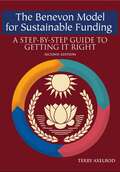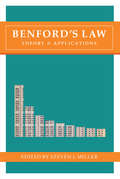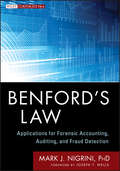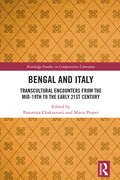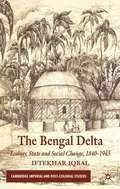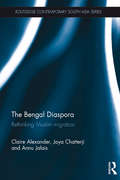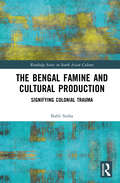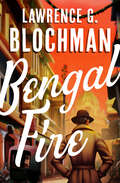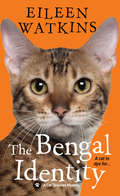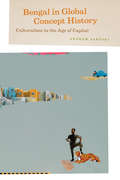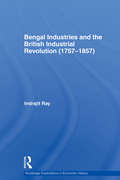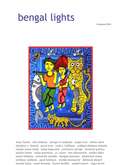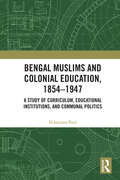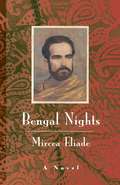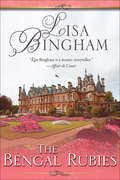- Table View
- List View
Benevolent Colonizers in Nineteenth-Century Australia: Quaker Lives and Ideals (Cambridge Imperial and Post-Colonial Studies Series)
by Eva BischoffThis book reconstructs the history of a group of British Quaker families and their involvement in the process of settler colonialism in early nineteenth-century Australia. Their everyday actions contributed to the multiplicity of practices that displaced and annihilated Aboriginal communities. Simultaneously, early nineteenth-century Friends were members of a translocal, transatlantic community characterized by pacifism and an involvement in transnational humanitarian efforts, such as the abolitionist and the prison reform movements as well as the Aborigines Protection Society. Considering these ideals, how did Quakers negotiate the violence of the frontier? To answer this question, the book looks at Tasmanian and South Australian Quakers’ lives and experiences, their journeys and their writings. Building on recent scholarship on the entanglement between the local and the global, each chapter adopts a different historical perspective in terms of breadth and focused time period. The study combines these different takes to capture the complexities of this topic and era.
The Benevolent Deity
by Robert J. Wilson IIIThe years following the Great Awakening in New England saw a great theological struggle between proponents of Calvinism and the champions of Christian liberty, setting the stage for American Unitarianism. The adherents of Christian liberty, who were branded Arminians by their opponents, were contending for the liberty of the mind and the soul to pursue truth and salvation free from prior restraint.The Arminian movement took shape as a major, quasi-denominational force in New England under the guidance of particular clergymen, most notably Ebenezer Gay, minister of the First Parish in Hingham, Massachusetts, from 1718 to 1787. Despite his ubiquitous presence in the history of Arminianism, however, Gay has been a historical enigma. Robert J. Wilson's purpose in this biography is to trace Gay's long and fascinating intellectual odyssey against the evolving social, political, and economic life of eighteenth-century Hingham as well as the religious history of the coastal region between Boston and Plymouth.
The Benevolent Dictator: Empower Your Employees, Build Your Business, and Outwit the Competition
by Michael FeuerAn unconventional philosophy for starting and building a business that exceeds your own expectations What does it require to take a concept rapidly and effectively from mind to market? The Benevolent Dictator recognizes that entrepreneurship is a gauntlet. Those who succeed are benevolent dictators—able to make the intricate process happen in days, weeks and months to win. The Benevolent Dictator gives you no-nonsense how-to advice and examples that have worked. This non-traditional, gung-ho guide is not afraid to lay out the leadership methods that can effectively get a new business off the ground, and through the requisite fast-track growth phases that produce tangible success measured by your bottom line and your wallet. Learn critical specifics on how to move from idea development to build-out, through steps for continuous improvement, and on to the big cash out Features proven tools, strategies, and tactics that will help you bottle entrepreneurial lightning over and over again As the cofounder of office retail giant OfficeMax, the author turned a $3 million investment into a $1.5 billion sale in his 16 years as CEO Beating the competition is never easy. For those times when you need an iron hand, then you also need the wisdom to know when and how to use it. Whether you're a business student, aspiring entrepreneur, or a practicing executive, you need to discover the winning ways of The Benevolent Dictator.
Benevolent Empire: U.S. Power, Humanitarianism, and the World's Dispossessed (Pennsylvania Studies in Human Rights)
by Stephen PorterStephen Porter's Benevolent Empire examines political-refugee aid initiatives and related humanitarian endeavors led by American people and institutions from World War I through the Cold War, opening an important window onto the "short American century." <P><P>Chronicling both international relief efforts and domestic resettlement programs aimed at dispossessed people from Europe, Latin America, and East Asia, Porter asks how, why, and with what effects American actors took responsibility for millions of victims of war, persecution, and political upheaval during these decades. Diverse forces within the American state and civil society directed these endeavors through public-private governing arrangements, a dynamic yielding both benefits and liabilities. <P><P>Motivated by a variety of geopolitical, ethical, and cultural reasons, these advocates for humanitarian action typically shared a desire to portray the United States, to the American people and international audiences, as an exceptional, benevolent world power whose objects of concern might potentially include any vulnerable people across the globe. <P><P>And though reality almost always fell short of that idealized vision, Porter argues that this omnivorous philanthropic energy helped propel and steer the ascendance of the United States to its position of elite global power. <P><P>The messaging and administration of refugee aid initiatives informed key dimensions of American and international history during this period, including U.S. foreign relations, international humanitarianism and human rights, global migration and citizenship, and American political development and social relations at home. Benevolent Empire is thus simultaneously a history of the United States and the world beyond.
Benevolent Repression: Social Control and the American Reformatory-Prison Movement
by Alexander W. PisciottaThe opening, in 1876, of the Elmira Reformatory marked the birth of the American adult reformatory movement and the introduction of a new approach to crime and the treatment of criminals. Hailed as a reform panacea and the humane solution to America's ongoing crisis of crime and social disorder, Elmira sparked an ideological revolution. Repression and punishment were supposedly out. Academic and vocational education, military drill, indeterminate sentencing and parole-"benevolent reform"-were now considered instrumental to instilling in prisoners a respect for God, law, and capitalism. Not so, says Al Pisciotta, in this highly original, startling, and revealing work. Drawing upon previously unexamined sources from over a half-dozen states and a decade of research, Pisciotta explodes the myth that Elmira and other institutions of "the new penology" represented a significant advance in the treatment of criminals and youthful offenders. The much-touted programs failed to achieve their goals; instead, prisoners, under Superintendent Zebulon Brockway, considered the Father of American Corrections, were whipped with rubber hoses and two-foot leather straps, restricted to bread and water in dark dungeons during months of solitary confinement, and brutally subjected to a wide range of other draconian psychological and physical abuses intended to pound them into submission. Escapes, riots, violence, drugs, suicide, arson, and rape were the order of the day in these prisons, hardly conducive to the transformation of "dangerous criminal classes into Christian gentleman," as was claimed. Reflecting the racism and sexism in the social order in general, the new penology also legitimized the repression of the lower classes. Highlighting the disparity between promise and practice in America's prisons, Pisciotta draws on seven inmate case histories to illustrate convincingly that the "March of Progress" was nothing more than a reversion to the ways of old. In short, the adult reformatory movement promised benevolent reform but delivered benevolent repression-a pattern that continues to this day. A vital contribution to the history of crime, corrections, and criminal justice, this book will also have a major impact on our thinking about contemporary corrections and issues surrounding crime, punishment, and social control.
The Benevolent Society of Ill-Mannered Ladies (THE ILL-MANNERED LADIES #1)
by Alison GoodmanA high society amateur detective at the heart of Regency London uses her wits and invisibility as an &‘old maid&’ to protect other women in a new and fiercely feminist historical mystery series from New York Times bestselling author Alison Goodman. Lady Augusta Colebrook, &“Gus,&” is determinedly unmarried, bored by society life, and tired of being dismissed at the age of forty-two. She and her twin sister, Julia, who is grieving her dead betrothed, need a distraction. One soon presents itself: to rescue their friend&’s goddaughter, Caroline, from her violent husband. The sisters set out to Caroline&’s country estate with a plan, but their carriage is accosted by a highwayman. In the scuffle, Gus accidentally shoots and injures the ruffian, only to discover he is Lord Evan Belford, an acquaintance from their past who was charged with murder and exiled to Australia twenty years ago. What follows is a high adventure full of danger, clever improvisation, heart-racing near misses, and a little help from a revived and rather charming Lord Evan. Back in London, Gus can&’t stop thinking about her unlikely (not to mention handsome) comrade-in-arms. She is convinced Lord Evan was falsely accused of murder, and she is going to prove it. She persuades Julia to join her in a quest to help Lord Evan, and others in need—society be damned! And so begins the beguiling secret life and adventures of the Colebrook twins.
The Benevolent Society of Ill-Mannered Ladies: A rollicking, joyous Regency adventure, with a beautiful love story at its heart
by Alison Goodman'Goodman's ladies are the undercover Regency heroes we've been waiting for! This is sparkling, thrilling, romantic fun' TONI JORDANA high society amateur detective at the heart of Regency London uses her wits and invisibility as an 'old maid' to protect other women in a new and fiercely feminist historical mystery series from New York Times bestselling author Alison Goodman.What readers are saying:'A fabulous read, full of compelling characters with wit and depth, heart breaking and heart pounding moments make this a complete page turner' ⭐ ⭐ ⭐ ⭐ ⭐ 'What a thrilling ride this book was!' ⭐ ⭐ ⭐ ⭐ ⭐ 'This book was an absolute riot to read. The central cast is very well fleshed out and are a joy to get to know'⭐ ⭐ ⭐ ⭐'A really refreshing regency read that's a little bit different!'⭐ ⭐ ⭐ ⭐.........................Lady Augusta Colebrook, 'Gus', is determinedly unmarried, bored by society life, and tired of being dismissed at the age of forty-two. She and her twin sister, Julia, who is grieving her dead betrothed, need a distraction. One soon presents itself: to rescue their friend's goddaughter, Caroline, from her violent husband.The sisters set out to Caroline's country estate with a plan, but their carriage is accosted by a highwayman. In the scuffle, Gus accidentally shoots the ruffian, only to discover he is Lord Evan Belford, an acquaintance from their past who was charged with murder and exiled to Australia twenty years ago. With Lord Evan injured and unconscious, the sisters have no choice but to bring him on their mission to save Caroline. What follows is a high adventure full of danger, clever improvisation, heart-racing near misses, and a little help from a revived and rather charming Lord Evan.Back in London, Gus can't stop thinking about her unlikely (not to mention handsome) comrade-in-arms. She is convinced Lord Evan was falsely accused of murder, and she is going to prove it. She persuades Julia to join her in a quest to help Lord Evan, and others in need-society be damned! And so begins the beguiling secret life and adventures of the Colebrook twins.A rollicking and joyous adventure, with a beautiful love story at its heart, about two rebellious sisters forging their own path in Regency London..........................'If you love Georgette Heyer, you'll love [this]. Smart and sassy and featuring heroines of a certain age, this is the Regency I've been waiting for. Adventure! Mystery! A touch of romance!' JENN MCKINLAY'A must-read for lovers of the Regency and historical mysteries alike' JENNIFER ASHLEY'A truly delightful romp through the Regency period. Alison Goodman has crafted a feminist adventure story that will have you cheering on the unconventional Colebrook sisters in all their exploits' STEPHANIE MARIE THORNTON'Part heart-racing adventure, part gothic mystery, part tantalizing romance, and wholly wonderful' JOANNA LOWELL
The Benevolent Society of Ill-Mannered Ladies: A rollicking, joyous Regency adventure, with a beautiful love story at its heart
by Alison Goodman'Goodman's ladies are the undercover Regency heroes we've been waiting for! This is sparkling, thrilling, romantic fun' TONI JORDANA high society amateur detective at the heart of Regency London uses her wits and invisibility as an 'old maid' to protect other women in a new and fiercely feminist historical mystery series from New York Times bestselling author Alison Goodman.What readers are saying:'Taut, exciting, in turns angry, funny and poignant, with a fabulous romantic subplot, this is the new regency series I didn't know I was waiting for. Highly, highly recommended'⭐ ⭐ ⭐ ⭐ ⭐'A fabulous read, full of compelling characters with wit and depth, heart breaking and heart pounding moments make this a complete page turner' ⭐ ⭐ ⭐ ⭐ ⭐ 'What a thrilling ride this book was!' ⭐ ⭐ ⭐ ⭐ ⭐ 'This book was an absolute riot to read. The central cast is very well fleshed out and are a joy to get to know'⭐ ⭐ ⭐ ⭐'A really refreshing regency read that's a little bit different!'⭐ ⭐ ⭐ ⭐.........................Lady Augusta Colebrook, 'Gus', is determinedly unmarried, bored by society life, and tired of being dismissed at the age of forty-two. She and her twin sister, Julia, who is grieving her dead betrothed, need a distraction. One soon presents itself: to rescue their friend's goddaughter, Caroline, from her violent husband.The sisters set out to Caroline's country estate with a plan, but their carriage is accosted by a highwayman. In the scuffle, Gus accidentally shoots the ruffian, only to discover he is Lord Evan Belford, an acquaintance from their past who was charged with murder and exiled to Australia twenty years ago. With Lord Evan injured and unconscious, the sisters have no choice but to bring him on their mission to save Caroline. What follows is a high adventure full of danger, clever improvisation, heart-racing near misses, and a little help from a revived and rather charming Lord Evan.Back in London, Gus can't stop thinking about her unlikely (not to mention handsome) comrade-in-arms. She is convinced Lord Evan was falsely accused of murder, and she is going to prove it. She persuades Julia to join her in a quest to help Lord Evan, and others in need-society be damned! And so begins the beguiling secret life and adventures of the Colebrook twins.A rollicking and joyous adventure, with a beautiful love story at its heart, about two rebellious sisters forging their own path in Regency London..........................'If you love Georgette Heyer, you'll love [this]. Smart and sassy and featuring heroines of a certain age, this is the Regency I've been waiting for. Adventure! Mystery! A touch of romance!' JENN MCKINLAY'A must-read for lovers of the Regency and historical mysteries alike' JENNIFER ASHLEY'A truly delightful romp through the Regency period. Alison Goodman has crafted a feminist adventure story that will have you cheering on the unconventional Colebrook sisters in all their exploits' STEPHANIE MARIE THORNTON'Part heart-racing adventure, part gothic mystery, part tantalizing romance, and wholly wonderful' JOANNA LOWELL
The Benevon Model For Sustainable Funding: A Step-by-step Guide To Getting It Right, Second Edition
by Terry AxelrodDesigned for small to mid-sized nonprofits who want to get started implementing the Benevon Model for Sustainable Funding on their own and who want to do it right. With significant edits to nearly every page, this second edition gives you our up-to-date metrics, easy-to-follow scripts, templates, checklists, rules, and formulas. This book synthesizes Benevon s state-of-the-art work with more than 5,000 nonprofit teams of board members, volunteers, and staff and makes them available for first-time implementers. While this will not take the place of working with Benevon directly, if you are willing to take on and carefully follow the tried and tested directions here, you will avoid the biggest mistakes of self-implementation, and you will be rewarded with a breakthrough in sustainable funding for your favorite nonprofit organization.
Benford Draws a Blank
by Danielle DufayetBenford loves art, and his very first canvas is ready and waiting! But he can’t think of a single thing to paint. Not one! Nothing! His mind is completely BLANK! How will Benford break free from his painter’s block? Author Danielle Dufayet highlights the importance of believing in yourself, having confidence, and trusting your talent in this encouraging picture book. After all, there are no mistakes in art—just chances to be creative and inspired.
Benford's Law
by Steven J. MillerBenford's law states that the leading digits of many data sets are not uniformly distributed from one through nine, but rather exhibit a profound bias. This bias is evident in everything from electricity bills and street addresses to stock prices, population numbers, mortality rates, and the lengths of rivers. Here, Steven Miller brings together many of the world's leading experts on Benford's law to demonstrate the many useful techniques that arise from the law, show how truly multidisciplinary it is, and encourage collaboration.Beginning with the general theory, the contributors explain the prevalence of the bias, highlighting explanations for when systems should and should not follow Benford's law and how quickly such behavior sets in. They go on to discuss important applications in disciplines ranging from accounting and economics to psychology and the natural sciences. The contributors describe how Benford's law has been successfully used to expose fraud in elections, medical tests, tax filings, and financial reports. Additionally, numerous problems, background materials, and technical details are available online to help instructors create courses around the book.Emphasizing common challenges and techniques across the disciplines, this accessible book shows how Benford's law can serve as a productive meeting ground for researchers and practitioners in diverse fields.
Benford's Law: Applications for Forensic Accounting, Auditing, and Fraud Detection (Wiley Corporate F&A #616)
by Mark J. NigriniA powerful new tool for all forensic accountants, or anyone who analyzes data that may have been altered Benford's Law gives the expected patterns of the digits in the numbers in tabulated data such as town and city populations or Madoff's fictitious portfolio returns. Those digits, in unaltered data, will not occur in equal proportions; there is a large bias towards the lower digits, so much so that nearly one-half of all numbers are expected to start with the digits 1 or 2. These patterns were originally discovered by physicist Frank Benford in the early 1930s, and have since been found to apply to all tabulated data. Mark J. Nigrini has been a pioneer in applying Benford's Law to auditing and forensic accounting, even before his groundbreaking 1999 Journal of Accountancy article introducing this useful tool to the accounting world. In Benford's Law, Nigrini shows the widespread applicability of Benford's Law and its practical uses to detect fraud, errors, and other anomalies. Explores primary, associated, and advanced tests, all described with data sets that include corporate payments data and election data Includes ten fraud detection studies, including vendor fraud, payroll fraud, due diligence when purchasing a business, and tax evasion Covers financial statement fraud, with data from Enron, AIG, and companies that were the target of hedge fund short sales Looks at how to detect Ponzi schemes, including data on Madoff, Waxenberg, and more Examines many other applications, from the Clinton tax returns and the charitable gifts of Lehman Brothers to tax evasion and number invention Benford's Law has 250 figures and uses 50 interesting authentic and fraudulent real-world data sets to explain both theory and practice, and concludes with an agenda and directions for future research. The companion website adds additional information and resources.
Benford's Law and Macroeconomic Data Quality
by Jesus Gonzalez-Garcia Gonzalo PastorA report from the International Monetary Fund.
Bengal and Italy: Transcultural Encounters from the Mid-19th to the Early 21st Century (Routledge Studies in Comparative Literature)
by Paromita Chakravarti Mario PrayerThe ten essays collected in this book manifest the current global interest for trans-border dialogues and trace the origins and development of Italian and Bengali internationalisms in the period from the mid-19th to the early 20th century. Despite having differing political statuses and lacking a shared geographical or historical space, Bengal and Italy remained uniquely connected and, at times, actively sought to transcend different kinds of constraints in their search for a significant dialogue and mutual enrichment in the fields of literature, music, architecture, art, cinema, diplomacy, entrepreneurship, travels, education and intellectual engagement. In this context, the volume confronts strategies of evaluation adopted by prominent representatives of the Bengali and Italian cultural environments with particular emphasis on readings embedded in the moment of contact. Both regions benefited from this ‘elective affinity’ as they advanced along their respective paths towards a fuller awareness of their specific identity, and thus set a positive example of transcultural understanding which may provide inspiration in today’s world.
The Bengal Delta
by Iftekhar IqbalWith a focus on colonial Bengal, this book demonstrates how the dynamics of agrarian prosperity or decline, communal conflicts, poverty and famine can only be properly understood from an ecological perspective as well as discussions of state's coercion and popular resistance, market forces and dependency, or contested cultures and consciousness.
The Bengal Diaspora: Rethinking Muslim migration (Routledge Contemporary South Asia Series)
by Claire Alexander Joya Chatterji Annu JalaisIndia’s partition in 1947 and the creation of Bangladesh in 1971 saw the displacement and resettling of millions of Muslims and Hindus, resulting in profound transformations across the region. A third of the region’s population sought shelter across new borders, almost all of them resettling in the Bengal delta itself. A similar number were internally displaced, while others moved to the Middle East, North America and Europe. Using a creative interdisciplinary approach combining historical, sociological and anthropological approaches to migration and diaspora this book explores the experiences of Bengali Muslim migrants through this period of upheaval and transformation. It draws on over 200 interviews conducted in Britain, India, and Bangladesh, tracing migration and settlement within, and from, the Bengal delta region in the period after 1947. Focussing on migration and diaspora ‘from below’, it teases out fascinating ‘hidden’ migrant stories, including those of women, refugees, and displaced people. It reveals surprising similarities, and important differences, in the experience of Muslim migrants in widely different contexts and places, whether in the towns and hamlets of Bengal delta, or in the cities of Britain. Counter-posing accounts of the structures that frame migration with the textures of how migrants shape their own movement, it examines what it means to make new homes in a context of diaspora. The book is also unique in its focus on the experiences of those who stayed behind, and in its analysis of ruptures in the migration process. Importantly, the book seeks to challenge crude attitudes to ‘Muslim’ migrants, which assume their cultural and religious homogeneity, and to humanize contemporary discourses around global migration. This ground-breaking new research offers an essential contribution to the field of South Asian Studies, Diaspora Studies, and Society and Culture Studies.
The Bengal Famine and Cultural Production: Signifying Colonial Trauma (Routledge Series on South Asian Culture)
by Babli SinhaThe Bengal Famine and Cultural Production: Signifying Colonial Trauma analyses the various modes of representation used by Anglophone authors and artists in response to the Bengal Famine of 1943. Official imperial narratives blamed the famine on natural disaster, war, exploitation by merchants, and incompetent local officials rather than members of the imperial government and have remained dominant in the global public imaginary until recent years. The authors and artists referenced in this study appealed to elite Bengali, South Asian, and international audiences to resist imperial narratives that minimized or erased suffering and instead encouraged relief efforts, promoted nationalist movements, maintained collective memory, innovated ethical forms of representation, and prompted systemic change. They were part of an established tradition of English in the subcontinent as the language of empire and cosmopolitanism but are not accessible, widely taught, or well-known. The direct encounter with suffering was and remains insufficient for prompting systemic change or even engagement, and yet, the recognition of trauma is crucial for personal and collective well-being. The cultural production of famine writers and artists sought to integrate the suffering and agency of the destitute into narratives of Bengali and South Asian identity and of the Second World War. It is crucial to the Humanities to recognize this body of work as a cultural counter-discourse to the biopower of empire and to engage these texts as relevant to theories of trauma. The book will be of interest to researchers in the field of South Asian history, the history of the Bengal famine, South Asian Anglophone literature, twentieth century art history, and trauma theory.
Bengal Fire (The Inspector Prike Mysteries)
by Lawrence G. BlochmanAn impending wedding and two fiancées lead to murder on the Indian subcontinent in this Golden Age mystery featuring British CID Insp. Leonidas Prike. Unsavory press agent Harrison J. Hoyt gets word that his American fiancée is arriving in Calcutta—just in time for his wedding to someone else. To diffuse the situation, he turns to gold broker Lee Marvin. After all, Marvin owes him his life; it&’s the least he could do. But as Marvin delivers the bad news, he finds himself enchanted by the resilient blonde . . . Though Hoyt&’s bachelor dinner goes off without a hitch, he soon disappears after slipping Marvin a mysterious package. And when he shows up at his wedding the next day, it&’s as a corpse. The police surgeon suspects natural causes, but Inspector Prike and Marvin, who is convinced that Hoyt&’s dirty dealings have finally brought the man down, think otherwise. But what Marvin took possession of the night before—a nine-jewel talisman—ensnares him in the same web of duplicity. Hot on the case, Inspector Prike must untangle threads of blackmail, betrayal, and deception among Calcutta&’s upper crust, including Marvin, both jilted fiancées, a Maharajah, a big-game hunter, a disreputable journalist, and a Hawaiian purveyor of cheap cotton goods. What started out as a love triangle reveals the cold-hearted treachery of a very clever killer . . . &“An exceptionally well-written novel.&” —The Glasgow Herald
The Bengal Identity (A\cat Groomer Mystery Ser. #2)
by Eileen WatkinsEveryone knows a leopard can't change its spots. But can a thief hide the spots on a catnapped Bengal? Groomer Cassie McGlone is about to find out . . . With no ID for his pet, an agitated young man shows up at Cassie's Comfy Cats claiming his house has burned down and he needs to board his big, brown cat, Ayesha. But after a bath washes dye out of the cat's coat and reveals beautiful spots, Cassie suspects the exotic-looking feline may in fact be a valuable Bengal show cat, possibly stolen. At the same time, there are rumored sightings of a "wild cat" in the hills of Chadwick, New Jersey. Could there be a connection? When Ayesha's alleged owner turns up dead, it looks like whoever wants the beautiful Bengal is not pussyfooting around. Working with the police, Cassie and her staff need to be careful not to reveal the purloined purebred's whereabouts while they discreetly make inquiries to cat breeders to find her real owners. But after a break-in attempt rattles Cassie's cage, it's clear someone let the cat out of the bag. And when a second body is found, it's up to Cassie to spot the killer, who may be grooming her to be the next victim . . . Praise for The Persian Always Meows Twice “A delightful debut mystery. It's smart, well-plotted, and features a cast of characters—both human and feline—that I want to see more of. This book will be catnip for cat lovers.” —Laurien Berenson, author of Wagging through the Snow “The purr-fecf mystery to curl up with for a lovely cozy read, preferably with a cup of tea, cuddly cat optional but recommended.”—Leslie Meier, author of Turkey Trot Murder
Bengal in Global Concept History: Culturalism in the Age of Capital
by Andrew SartoriToday people all over the globe invoke the concept of culture to make sense of their world, their social interactions, and themselves. But how did the culture concept become so ubiquitous? In this ambitious study, Andrew Sartori closely examines the history of political and intellectual life in nineteenth- and twentieth-century Bengal to show how the concept can take on a life of its own in different contexts. Sartori weaves the narrative of Bengal's embrace of culturalism into a worldwide history of the concept, from its origins in eighteenth-century Germany, through its adoption in England in the early 1800s, to its appearance in distinct local guises across the non-Western world. The impetus for the concept's dissemination was capitalism, Sartori argues, as its spread across the globe initiated the need to celebrate the local and the communal. Therefore, Sartori concludes, the use of the culture concept in non-Western sites was driven not by slavish imitation of colonizing powers, but by the same problems that repeatedly followed the advance of modern capitalism. This remarkable interdisciplinary study will be of significant interest to historians and anthropologists, as well as scholars of South Asia and colonialism.
Bengal Industries and the British Industrial Revolution (Routledge Explorations In Economic History Ser. #51)
by Indrajit RayThis book seeks to enlighten two grey areas of industrial historiography. Although Bengal industries were globally dominant on the eve of the industrial revolution, no detailed literature is available about their later course of development. A series of questions are involved in it. Did those industries decline during the spells of British industrial revolution? If yes, what were their reasons? If not, the general curiosity is: On which merits could those industries survive against the odds of the technological revolution? A thorough discussion on these issues also clears up another area of dispute relating to the occurrence of deindustrialization in Bengal, and the validity of two competing hypotheses on it, viz. i) the mainstream hypothesis of market failures, and ii) the neo-marxian hypothesis of imperialistic state interventions
Bengal Lights
by Editor Khademul Islam Guest Editors C.P. Heiser David ShookA special edition of Bengal Lights, Bangladesh's leading English language literary journal, guest-edited by the editors of the Unnamed Press and Phoneme Media. A liberal exploration of the concept of "the guest” featuring Etgar Keret, Mario Bellatin, Sesshu Foster, Ben Ehrenreich, Stacy Hardy, Douglas Kearney, Amjad Nasser, Rita Indiana, Pavel Šrut, Inongo-vi-Makomè, Angie Cruz, Antonella Anedda, Sharbari Z. Ahmed, Paul Holzman, Carly J. Hallman, Ramón Esono Ebalé, Prisionero Gringo, Khademul Islam, Mandy Kahn, Nylsa Martínez, Anthony Seidman, Nazir Hossain, Malka Older, Sudipta Chakma Mikado, Katia Kapovich, Zvonko Karanovic, Edwin Smet, J. C. Reyes, and Ikhtisad Ahmed.
Bengal Muslims and Colonial Education, 1854–1947: A Study of Curriculum, Educational Institutions, and Communal Politics
by Nilanjana PaulThis book examines the impact of British education policies on the Muslims of Colonial Bengal. It evaluates the student composition and curriculum of various educational institutions for Muslims in Calcutta and Dacca to show how they produced the educated Muslim middle class. The author studies the role of Muslim leaders such as Abdul Latif and Fazlul Huq in the spread of education among Muslims and looks at how segregation in education supported by the British fueled Muslim anxiety and separatism. The book analyzes the conflict of interest between Hindus and Muslims over education and employment which strengthened growing Muslim solidarity and anti- Hindu feeling, eventually leading to the demand for a separate nation. It also discusses the experiences of Muslim women at Sakhawat Memorial School, Lady Brabourne College, Eden College, Calcutta, and Dacca Universities at a time when several Brahmo and Hindu schools did not admit them. An important contribution to the study of colonial education in India, the book highlights the role of discriminatory colonial education policies and pedagogy in amplifying religious separatism. It will be useful for scholars and researchers of modern Indian history, religion, education, Partition studies, minority studies, imperialism, colonialism, and South Asian history.
Bengal Nights
by Mircea Eliade Catherine SpencerSet in 1930s Calcutta, this semi-autobiographical novel by the world-renowned scholar Mircea Eliade details the passionate affair of Alain, a young French engineer, and Maitreyi, the daughter of his Indian employer. At once horrifying and deeply moving. "Bengal Nights" is also a cruel account of the wreckage left in the wake of a young man's self-discovery. Over forty years passed by, the real Maitreyi Devi read Eliade's erotically charged novel and wrote her response, "It Does Not Die".
The Bengal Rubies
by Lisa BinghamA love torn apart by fate is rejoined once more by destiny in this enthralling Regency romance penned by “a master storyteller” (Affaire de Coeur). Long ago, a young boy and girl were set to one day wed—he, the son of a schoolmaster; she, the daughter of a beautiful noblewoman. Before that happened, the girl’s tyrannical monster of a father interceded, hiding his daughter away and forcing the boy into exile . . . Now, the beautiful Aloise Crawford is set to be auctioned off to the highest bidder by her own father. But she escapes the ship carrying her—only to find herself at the feet of a dark stranger with a face as angry as it is alluring. For years, Slater McKendrick has lived in the shadows, awaiting his chance to seek vengeance against the man who stole his life, his love, and family’s precious jewels, the Bengal Rubies. And when Aloise arrives on his lonely beach hideaway, it seems as if the opportunity has at last been delivered into his arms. As captor and captive grow closer, they soon realize that they are bound by something more than either can resist—and that their only chance for true freedom is to face the dangers of the past.
